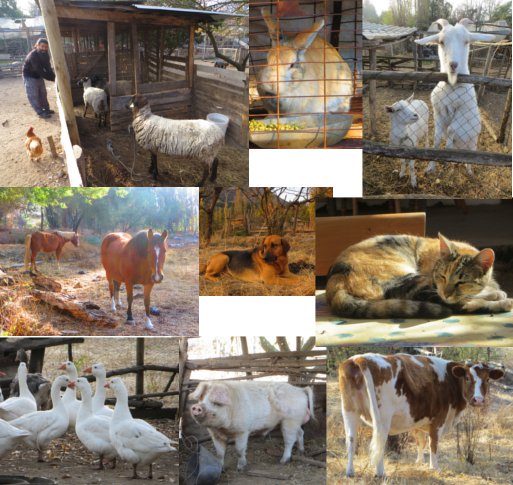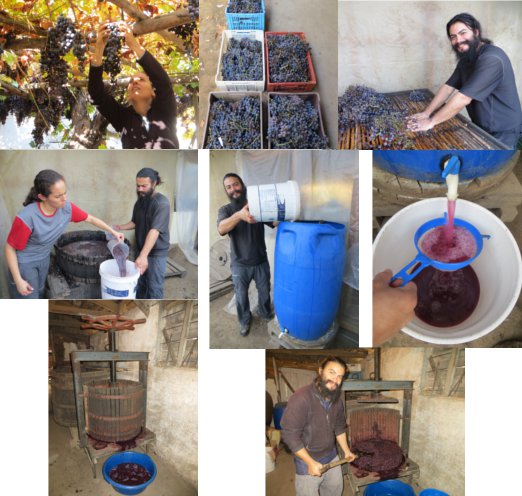WWOOFing in Pelequen
Since we were planning our itinerary in Chile, we had the goal to do WWOOFing in the country and hopefully find a farm with a vineyard where we could learn and participate during the process of wine making. Our plan is common amongst the travelers that do volunteer in the country and these types of farms receive several requests. We were fortunate to be accepted in Granja La Viñita located a little outside Pelequen town in Central Chile and we WWOOFed there for 11 days from May 14, 2015. This family farm has been the maternal house to three generations and they continue preserving the traditions of growing the pais grapes brought from Spain to Chile.
Today, the grape is almost unknown and extinct in this world famous wine producing country. Since the times of the original owners, the pais grape has been grown, harvested, and used to produce handmade grape chicha and vinegar. Granja La Viñita is also home to different animals: horses, cows, sheep, goats, a big pig, rabbits, geese, a duck, chickens, cats, and dogs. Feeding the animals in the mornings and evenings was one of the daily tasks we really enjoyed. We were welcomed in this organic family farm by the caretaker Ximena Barahona, granddaughter of the original owners. We were also pleased to share time and nice conversations with Ximena’s older sister and brother in law, Alicia and Sergio, they have been married for almost 50 years and build a house inside the family property 8 years ago which became their permanent home a few years ago after they retired.


During our days in the farm our main assignments varied day by day but we were always in charge of feeding the animals in the morning and evenings. We both enjoyed feeding the animals as it allowed us to be in direct contact with them and observe their behaviors. This had been the first farm where we volunteered that had such a big range of animals. The chicken, geese, sheep, duck, horses, cows, dogs, and cats have free mobility within extensive areas of the farm and we were happy to see them interacting with each other and living. Only the pig, goats, and rabbits were inside enclosed areas and restricted to move freely, which was sad but understandable due to the way life is in the farm. The geese were particularly interesting to watch, always moving together like a noisy cloud of white feathers. The geese love being in the water and we admired the elegant shape of their necks while bathing. At the time of feeding, we witnessed the intelligence of the animals who have learned the how, where, and when their caretakers provide them with water and food daily.
Feeding the Pigs
All the animals seem to expect us, they all acted with clear knowledge of what we will do, predicting where the food and water will be placed to the point of stealing food from each other when they got a chance. The chickens always seem jealous of the duck for being giving the appetizing leftover food of the pig without any efforts. We saw the duck getting physically attacked by a chicken right before we fed her because she wanted the food. The pig was always impatient and demanding on getting his food, we never got used to seeing his big head coming out of his cage while screaming and drooling. Gisela fed the pig often, bringing his food container closer to the fence of his cage with a long stick while trying to keep him entertained and calm was not easy. We definitely did not learn to predict his behavior and did not have any other choice but to laugh each time he surprised us with his big face. Sal took care of feeding the hungry goats daily. He also was in charge of letting the sheep out into the fields to wonder around and eat in the mornings. Depending on where the sheep were by the end of the day, returning them to their cage before sunset sometimes required the teamwork of both Sal and Gisela.
Granja la Viñita has grapes and several other fruit trees, including green and red apples, pomegranate, quince, persimmons, oranges, limes, and avocado. From these fruits, delicious jams and preserves have been made throughout the years. Ximena and her mother had in the past a jam production company called Rigolengo like the name of the area where their farm is located.


In the most recent years and under the leadership of Ximena, the farm became a center for rural tourism where families and school children are educated about the activities and cycles of an organic farm. Visitors get hands-on information about compost, animals, the process of planting and harvesting different plants, and the process of making of the traditional chicha of grapes, which is made by hand under natural fermentation and without the use of electric machines or fire. The farm is a unique gem of knowledge and history when it comes to traditional organic farming and the process of wine making in a very industrialized country where these techniques are almost unheard of. Ximena, who is a great believer of agriculture and rural tourism, said that seeing the surprised and excited faces of children and adults that come from the city to finally discover how the plants they eat grow and how life in a farm looks like instead of what they have seen only in books or TV is always rewarding. With Ximena, Alicia, and Sergio we had conversations about the issues of our society where a job as vital as farming from which we all human beings depend on is not appreciated, respected, and well paid as other professions.
This is the reason why most children today dream of becoming a doctor, a soccer player, a movie star, or an engineer but not a farmer. This is also why most farmers hope for a different future for their own descendants, a future where they can earn a better living, away from their farms. Our lands are getting abandoned and our cities keep growing without proportion. We all eat every day but we have no idea how and from where our food gets to our plates. Small farmers are a novelty, because big companies of massive food production have taken over the market of growing what we eat. Ximena said that in Chile the government has placed a strong effort to provide support, information, and financial assistance to the small farmers, but sadly the number of individuals interested in accomplishing this important job are always less and less. She herself struggles to find someone that could work at the farm because the area of central Chile is short of workers compared with the demand. Adding to the negative effect that the socioeconomic dynamics of developing countries has over agriculture is the global warming phenomenon that has also impacted the life of Granja la Viñita as well as many other farms in Chile. During the last years, long periods of dry season are changing the green and prosperous spirit of this family land. This year for example, the harvest of grapes and other fruit has significantly decreased due to the lack of water. It was May when we visited the farm and the hopes of April showers, a month famous for its rains, diminished while waiting for drops of water from the sky which never came. Many projects at the farm had to be postponed. Many fruit trees planted by Ximena and Alicia’s grandparents and parents had died while waiting for the rain. The small channels that run throughout the property to water the trees, animals, and fields were often dried. The few days water came down the hill and filled the channels were exciting times and an experience that clearly showed how critical the situation is. This time was a generalized atmosphere of expectation and nostalgia over the land of Ximena and Alicia’s childhood and youth. They often talked about how they remembered it and how much they wish it could be again. A fertile land where everything grew and everyone used to laugh and harvest. Big food producing companies have the money and power to deviate the direction of rivers, set watering systems, and bring water from afar, unlike small family farms like Granja La Viñita that rely on the rain and local rivers to survive. Global warming is setting them up for extinction. The pollution caused by industrialized, “developed,” and carbon monoxide producer societies like ours is destroying life as we know it on earth.
There are many things about the reality of our world that concern us and make us feel powerless. Regardless of these issues, we found out that focusing in what we can actually do to have a positive impact in our reality is a better strategy of living. This is why we try our best to take advantage of daily opportunities we get to learn and live in concordance with our values. During our WWOOFing experience in Chile our favorite task was harvesting the grapes and making the fresh wine cider (grape chicha). Ironically, thanks to the lack of rain, the grapes grew later this year and we had the unique opportunity to complete this task. This traditional process took a few days and steps, we hope our pictures and descriptions could illustrate it clearly:
We first harvest the grapes, place them and separate them into plastic crates removing the damaged parts of the fruit. This process took a-day-and-a-half for both of us to complete.
After harvesting, we smashed the grapes manually by using a bamboo filter. The grapes are placed on top of this bamboo filter and with the grape’s stem we would rub the grapes with our hands. Then the grape stems are shaken, cleaned, and removed from the grapes and juice. The grape skin and juice are drained into a wood container below the bamboo filter. This took about half a day for both of us to do.
The grape juice, skin, and seeds inside the wood container are then placed into a big plastic container with a draining faucet on the bottom. Before putting the juice inside, a filter is created with a big bunch of grape stems and a wood stick that stays firm inside the container serving as an internal filter to avoid any obstructions in the faucet. The juice and pieces of fruit are poured into the big container with jars. This process only took a few minutes. The container is covered with a plastic on the top and left for 2 to 3 days for the initial fermentation to take place.
After 3 days, we drained the faucet and got the grape juice out of the container filtering it with a small strainer. All this juice was poured into another big container where it will rest covered for fermentation for another week until the fresh wine cider is ready. In this farm this grape juice is also used to produce grape vinegar by letting it ferment for a longer period of time.
The left over grape skin and seeds is put into a wood manual press overnight to remove all the remaining juice. At the end, the fruit is removed from the press and placed into other containers that can be used to make liquor or feeding the farm animals.
Squeezing Grapes
Living for 11 days with a Chilean family in the countryside was wonderful. We learned about not only about organic farming, but also Chilean food, history, culture, and the specific words/dialect/slang they use in Spanish. Being in contact with the animals and experiencing the process of harvesting and making fresh wine cider made our WWOOFing experience simply unforgettable. 🙂
